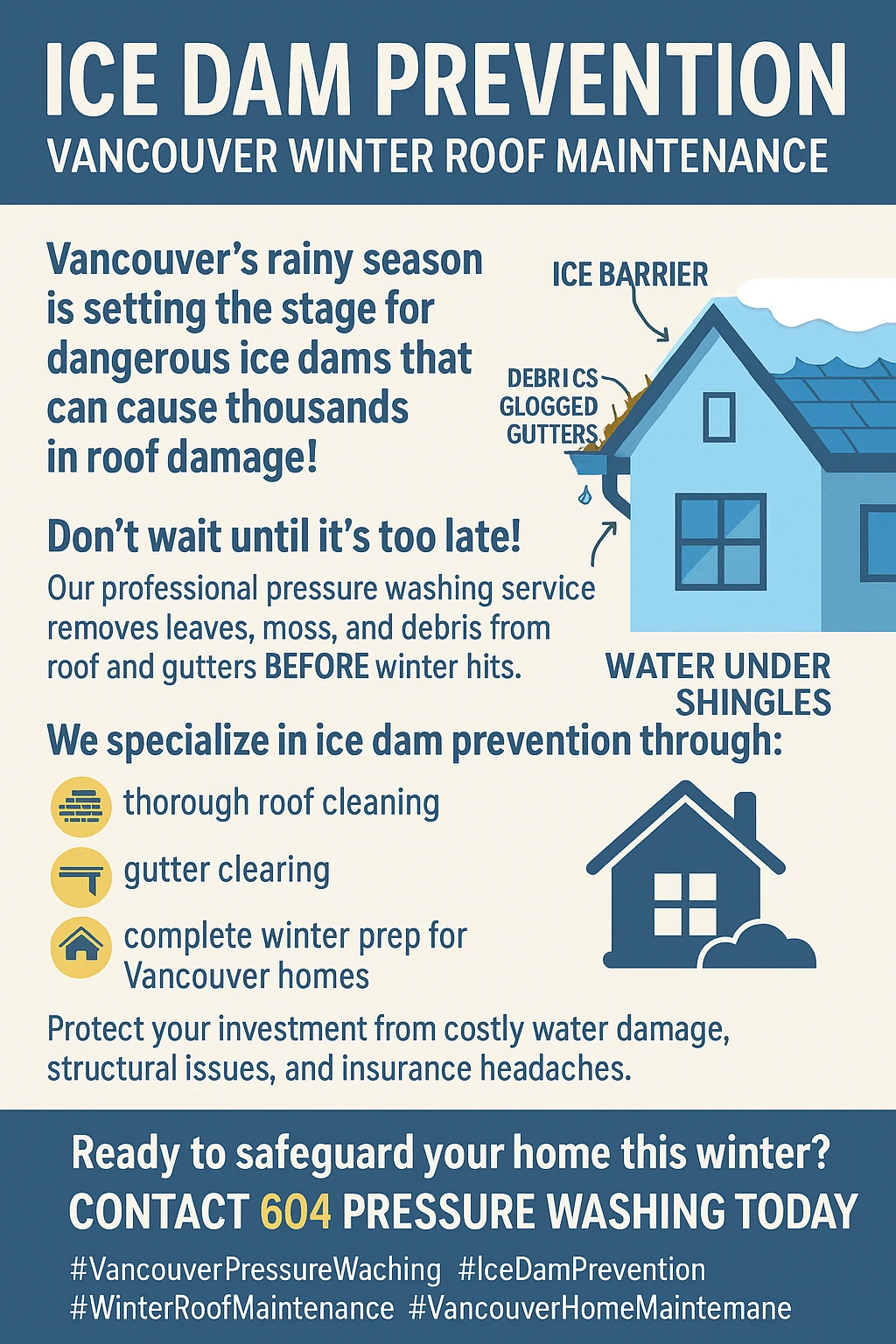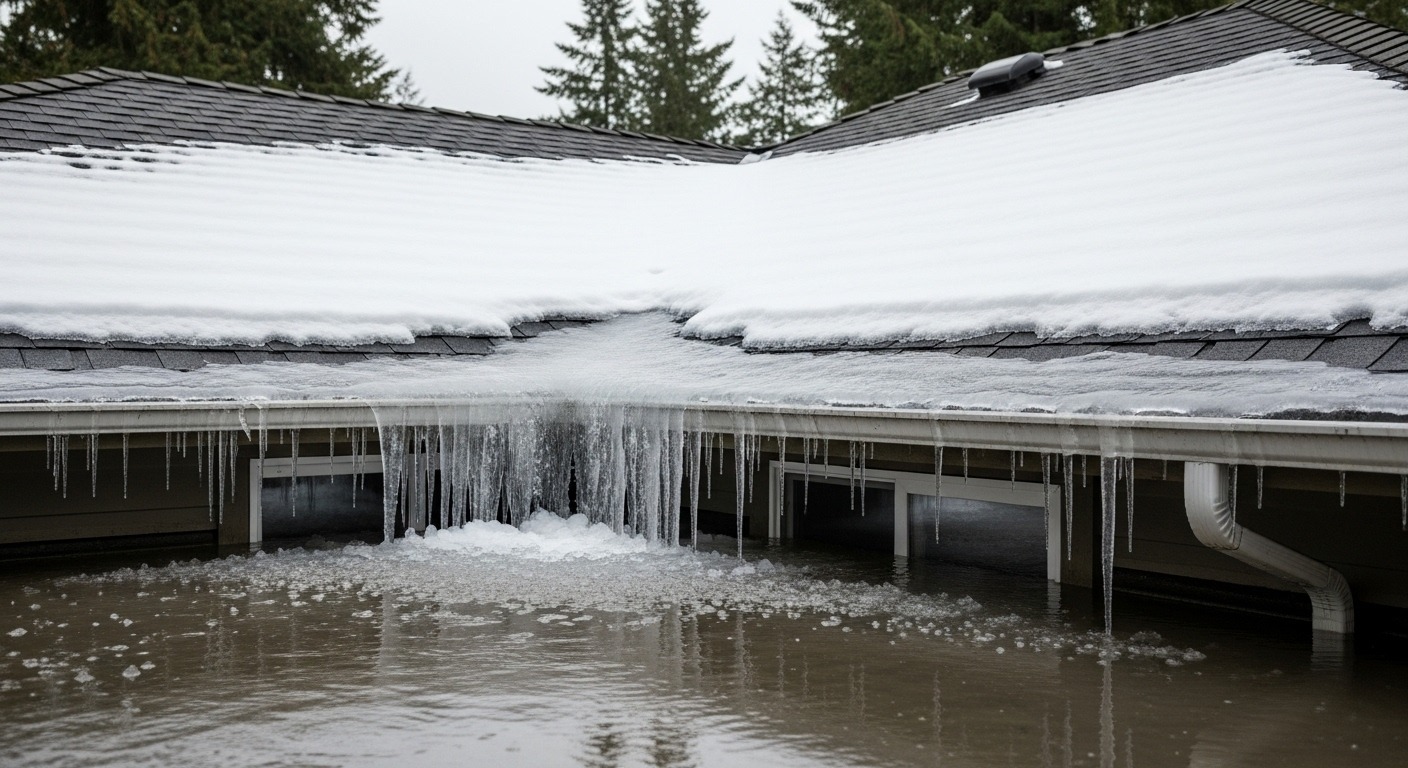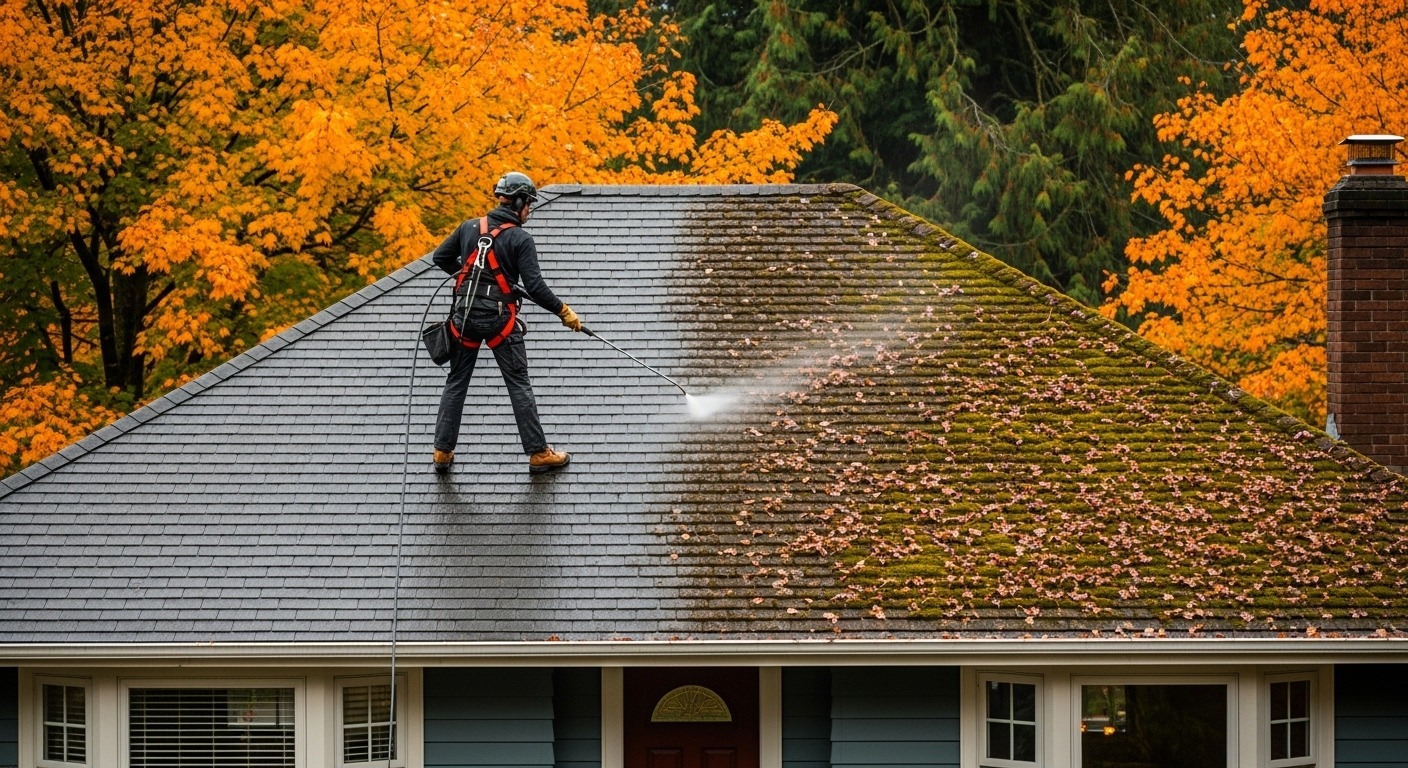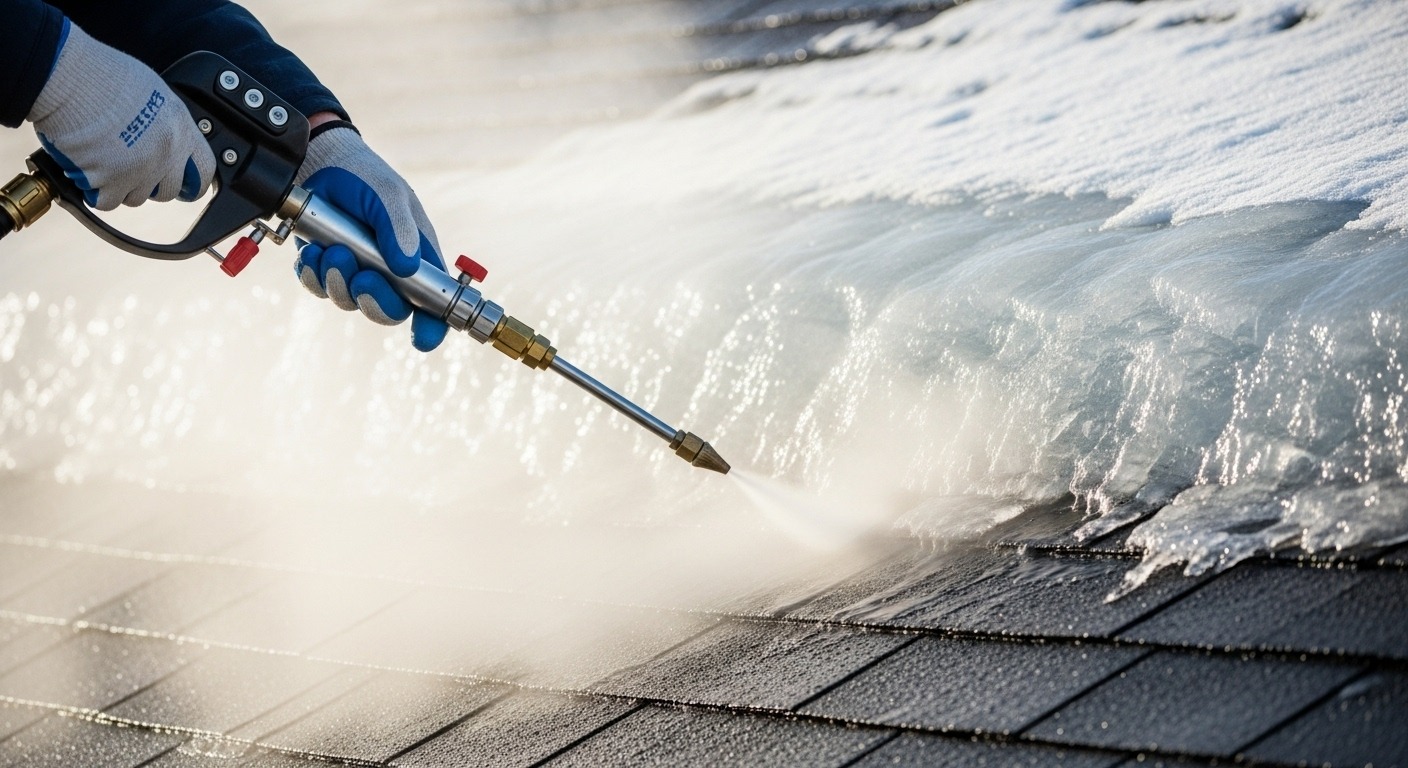Why Vancouver’s Rainy Season is Creating Ice Dams on Your Roof (And How Professional Pressure Washing Prevents Winter Damage)
Tired of discovering water damage in your attic after every winter freeze? Vancouver’s unique coastal climate creates perfect conditions for ice dam formation that can cause thousands of dollars in damage to your home.Vancouver homeowners face a winter challenge that’s distinctly different from the rest of Canada. While cities like Calgary and Winnipeg deal with sustained freezing temperatures, Vancouver’s coastal location creates a complex pattern of freeze-thaw cycles that make ice dam formation particularly problematic. The city receives over 1,200mm of rainfall annually, with winter temperatures hovering around 6°C, creating ideal conditions for snow to melt and refreeze repeatedly on roof surfaces. This constant cycle of melting and refreezing, combined with poor attic insulation and clogged drainage systems, leads to ice dams that can cause extensive water damage to homes.The formation of ice dams occurs when heat from your home’s interior escapes through inadequate insulation, warming portions of your roof deck and melting accumulated snow. This melted snow flows down to the colder eaves where it refreezes, creating a barrier that traps additional meltwater behind it. When enough water backs up, it’s forced under shingles and into your home, causing damage to ceilings, walls, insulation, and potentially creating dangerous mold growth conditions.
Key Outtakes:
- Vancouver’s coastal climate creates unique ice dam formation conditions with frequent freeze-thaw cycles
- Professional pressure washing removes debris and moss that contribute to poor roof drainage and ice dam formation
- Comprehensive winter preparation including roof cleaning can prevent damage costs ranging from $300 to $15,000
- Proper timing of maintenance activities is crucial, with fall roof cleaning being the most critical period
- Professional services offer specialized equipment and expertise that typical homeowners cannot replicate

Understanding Vancouver’s Unique Ice Dam Formation Conditions
Vancouver’s position on Canada’s west coast creates weather patterns that make ice dam formation both more likely and more complex than in inland cities. The Pacific Ocean’s moderating influence means temperatures rarely drop to the extreme lows experienced in prairie provinces, but this moderate climate paradoxically increases ice dam risk. During typical Vancouver winters, temperatures fluctuate between slightly above and below freezing, creating the perfect environment for the melt-refreeze cycle that drives ice dam formation.The city experiences sub-zero temperatures approximately 46 days per year, often in short bursts rather than extended cold snaps. This pattern prevents complete freezing of roof surfaces while still allowing edge freezing where eaves extend beyond heated building envelopes. When combined with Vancouver’s high humidity levels that typically hover around 80% during winter months, these conditions create perfect environments for ice accumulation and organic debris growth on roof surfaces.Vancouver’s abundant tree coverage, with over 150,000 street trees throughout the city, creates varying amounts of shade and shelter that affect how snow accumulates and melts on different properties. North Vancouver faces particular challenges due to shade from surrounding mountains creating conditions for moss proliferation and slower snow melt in some areas, while other sections receive direct mountain reflection that accelerates melting. This uneven heating and cooling pattern across roof surfaces contributes significantly to ice dam formation.The relationship between Vancouver’s building codes and actual ice dam prevention requirements reveals another layer of complexity. While the city’s building code requires roofs to handle minimum snow loads of 1.8 kPa, this standard addresses structural integrity rather than ice dam prevention. The recommended R-40 insulation value for Vancouver roofs helps prevent ice formation along eaves, but many older homes fall short of this standard, particularly in heritage neighborhoods that predate modern insulation requirements.
How Professional Pressure Washing Prevents Ice Dam Formation
The connection between professional pressure washing and effective ice dam prevention extends far beyond simple cleaning to address fundamental drainage and heat transfer issues that create conditions for ice formation. Professional pressure washing services provide multiple pathways to prevention by removing debris that blocks proper water flow, eliminating moss and algae growth that retains moisture against roof surfaces, and preparing drainage systems to handle Vancouver’s challenging winter precipitation patterns.Debris accumulation represents one of the most significant contributing factors to ice dam formation that homeowners can effectively control. Accumulated organic matter, including leaves, moss, algae, and other debris, creates barriers to proper water drainage across roof surfaces. When snow melts during Vancouver’s frequent winter thaw periods, this debris prevents efficient flow of meltwater to gutters and downspouts, causing water to pond in areas where it can refreeze and begin ice dam formation. Professional pressure washing removes these barriers systematically, ensuring that when snow does melt, resulting water can flow freely off roof surfaces.Moss removal through professional pressure washing provides particularly significant benefits in Vancouver’s humid coastal climate. Moss growth thrives in the city’s persistent moisture conditions and creates irregular surfaces that impede proper water drainage. When snow accumulates on moss-covered surfaces, the combination of retained moisture and irregular drainage patterns creates ideal conditions for ice dam formation. Professional services use specialized equipment and techniques to remove moss completely without damaging underlying roofing materials, something that typical homeowner approaches often fail to achieve.The timing of professional pressure washing services proves crucial for effective ice dam prevention in Vancouver’s climate. Services recommend completing comprehensive roof cleaning during fall months, particularly September through November, before winter weather conditions make debris removal more difficult and dangerous. During this critical period, Vancouver experiences heavy rainfall that makes wet organic matter adhere more strongly to roof surfaces, requiring professional-grade equipment to remove effectively.Professional pressure washing addresses heat transfer issues that contribute to ice dam formation by removing dark-colored organic growth from roof surfaces. Clean roof surfaces maintain better thermal uniformity and restored reflective properties, reducing unwanted heat absorption that can contribute to uneven snow melt patterns. This thermal regulation helps prevent the temperature differentials between upper roof areas and eaves that drive ice dam formation.
Professional Equipment and Expertise Advantages
Understanding the significant differences between professional ice dam prevention services and general maintenance approaches helps homeowners make informed decisions about winter roof protection. Professional services possess specialized equipment, training, and insurance coverage specifically designed for ice dam prevention and removal, setting them apart from general contractors or DIY approaches that may inadvertently cause damage while attempting to address ice dam problems.Professional pressure washing equipment provides capabilities that typical homeowners cannot replicate safely or effectively. Steam-based cleaning systems used by qualified services operate at temperatures up to 330°F while maintaining controlled water flow rates that prevent addition of excess moisture during cleaning operations. These systems can effectively remove organic buildup and prepare surfaces for optimal winter drainage without the risk of damage associated with high-pressure water applications or mechanical removal methods.The diagnostic capabilities provided by professional services extend far beyond simple cleaning to encompass comprehensive assessment of conditions that contribute to ice dam formation. Experienced professionals can identify heat loss patterns, insulation deficiencies, ventilation problems, and architectural features that create ice dam risk on specific properties. This diagnostic expertise allows for targeted solutions that address root causes rather than simply treating symptoms after problems have already developed.Insurance considerations for professional services provide important protection for homeowners that DIY approaches cannot offer. Professional ice dam prevention and removal specialists typically carry insurance specifically designed for this type of work, ensuring coverage for potential damage that could occur during cleaning or removal processes. This specialized insurance addresses unique risks associated with working on icy roof surfaces and using specialized equipment near vulnerable roofing materials.Professional services understand proper sequencing and techniques for both prevention and emergency removal that minimize risk of additional damage. This includes knowledge of how to create drainage channels that allow melted ice to flow safely off roof surfaces, understanding of which removal methods are appropriate for different roofing materials, and expertise in protecting interior spaces from water damage during removal processes. The systematic approaches used by professionals reduce risk while ensuring thorough problem resolution.Training and certification requirements for professional ice dam services ensure that technicians understand both technical aspects of prevention and removal as well as safety protocols for working in dangerous winter conditions. Professional services maintain current training on equipment operation, safety procedures, and best practices for protecting both workers and property during ice dam prevention and removal operations.
Comprehensive Winter Maintenance Strategies
Effective ice dam prevention requires coordinated implementation of multiple maintenance strategies that work together throughout the year to maintain proper roof function during challenging winter conditions. Professional maintenance approaches recognize that ice dam prevention is not a single action but rather a comprehensive system of measures that address insulation, ventilation, debris removal, and ongoing monitoring to prevent conditions that lead to ice dam formation.Attic insulation optimization forms the foundation of professional ice dam prevention strategies, with energy auditors recommending R-values up to 60 for comprehensive protection, significantly higher than standard building code requirements. The type and installation method of insulation proves equally important, with blown-in cellulose and spray foam providing superior air sealing properties compared to traditional fiberglass batts. Proper installation requires attention to thermal bridging, comprehensive air sealing, and complete coverage that eliminates heat loss pathways contributing to uneven roof heating patterns.Ventilation system design and maintenance play critical roles in regulating attic temperature and preventing moisture buildup that can lead to rot and mold growth. Proper ventilation systems include both soffit vents for intake and ridge or gable vents for exhaust, creating a continuous airflow path that removes warm, moist air from attic spaces. Regular inspection and cleaning of these vents prevents blockage from debris or insect nests that can impede airflow.
Frequently Asked Questions About Ice Dam Prevention in Vancouver
Q1: How often should I have my roof professionally cleaned to prevent ice dams?
For most Vancouver homes, professional roof cleaning every 1 to 2 years is sufficient for ice dam prevention. However, properties with heavy tree coverage or those in particularly damp, shaded areas may benefit from annual cleaning to manage moss and debris accumulation.
Q2: Can I remove an ice dam myself?
DIY ice dam removal is strongly discouraged due to significant risks of personal injury and property damage. Using improper tools like hammers or axes can destroy shingles, while using salt or chemical de-icers can damage roofing materials, gutters, and surrounding landscaping. Professional steam removal is the safest and most effective method.
Q3: Will new insulation completely stop ice dams from forming?
While proper insulation is a critical component of prevention, it may not completely eliminate risk on its own. Comprehensive prevention requires a multi-faceted approach that also includes proper attic ventilation and regular roof and gutter cleaning to ensure clear drainage paths for meltwater.
Q4: Does my homeowner’s insurance cover damage from ice dams?
Most standard homeowner’s insurance policies cover water damage resulting from ice dams. However, policies vary, and some may have specific exclusions or require homeowners to demonstrate they’ve taken reasonable preventive measures. It’s essential to review your specific policy with your insurance provider.
Wrapping Up Your Winter Roof Protection Strategy
Protecting your Vancouver home from the costly and destructive effects of ice dams requires a proactive, year-round maintenance strategy. The city’s unique coastal climate, characterized by frequent freeze-thaw cycles and high moisture levels, creates a perfect storm for ice dam formation on unprepared roofs. By understanding these local conditions and implementing a comprehensive prevention plan, homeowners can avoid thousands of dollars in potential repairs.
The cornerstone of this strategy is professional roof cleaning and maintenance. Services like pressure washing remove the moss and debris that clog drainage systems, while professional assessments can identify underlying issues with insulation and ventilation. Investing in professional care before the winter season sets in is the most effective way to ensure your roof is ready to handle whatever Vancouver’s winter weather brings, keeping your home safe, dry, and damage-free.

